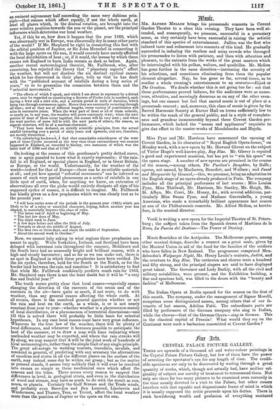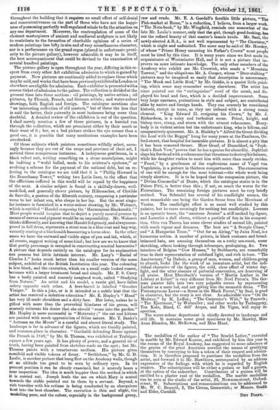Sim 2rto,
CRYSTAL PALACE PICTURE GALLERY.
THERE are upwards of a thousand oil and water-colour paintings in the Crystal Palace Picture Gallery, but few of them have the power of arresting the spectator's eye for any length of time. The credit- able specimens are only to be discovered by wading through a great quantity of works, which, though not actually bad, have neither ori- ginality of subject nor novelty of treatment to recommend them. Not only are there far too many pictures to be examined even cursorily in the time usually devoted to a visit to the Palace, but other causes interfere with that equable and dispassionate frame of mind in which it is usually supposed the critic proceeds upon his duties. There is such bewildering wealth and profusion of everything scattered
throughout the building that it requires no small effort of self-denial and concentmtiveness on the part of those who have not the happi- ness of possessing perfectly welregulated minds to fix the attention on any one department. Moreover, the contemplation of some of the choicest masterpieces of ancient and medimval sculpture is not likely to contribute to the formation of charitable opinions of a series of modem paintings less lofty maim and of very miscellaneous character, nor is a performance on the grand organ (placed in unfortunate proxi- mity to the picture gallery), however admirable it may be in itself, the best accompaniment that could be devised to the examination of several hundred paintings.
The picture gallery is open throughout the year, differing in this re- spect from every other Art exhibition admission to which is gained by payment. New pictures are continually added to replace those which maybe sold, and works that have been previonslyexhibitedinLondon or elsewhere areeligible for admission. Each exhibitor is presented witha season ticket of admission to the palace. The collection is divided at the present time into three sections : oil paintings, by native artists ; oil pictures, by Flemish, French, and German artists; and water-colour drawings, both English and foreign. The catalogue mentions also "an interesting collection of old masters," but of these the less that is said the better, their paternity in most instances being more than doubtful. A detailed review of the exhibition is out of the question. I shall merely mention a few of those pictures, in a hurried run through the collection, which are prominent either by their merit or their want of it ; but, as a bad picture strikes the eye sooner than a good one, it is possible that many meritorious examples have been overlooked.
Of those subjects which painters sometimes wilfully select, seem- ingly because they are out of the scope and province of their art, I noticed three conspicuous instances. A lachrymose gentleman, in a black velvet suit, writing something on a stone mantelpiece, might be inditing a " woful ballad, made to his mistress's eyebrow," or evolving a scheme for the payment of the national debt, but on re- ferring to the catalogue we are told that it is "Phillip Reward in the Beauchamp Tower," writing two Latin lines, to the effect that the afflictions suffered in this world will be repaid by the happiness of the next. A. similar subject is found in a skilfully-drawn, well- modelled, and generally clever picture, by Hillemacher, of Clotilde de Surville, a poetess of the fifteenth century, composing a particular verse to her infant son, who sleeps in her lap. But the most singu- lar instance is furnished in a water-colour drawing, by Mr. Welinert, which is entitled "Handel composing the 'Harmonious Blacksmith.'" Most people would imagine that to depict a purely mental process by means of canvas and pigment would be an impossibility. Mr. Wehnert thinks different ly, and knowing that Handel fed grossly, and always com- posed in full dress, represents a stout man in a blue coat and bag-wig, vacantly staring at a blacksmith hammering a horse-shoe. In the other, cases we have the outward and visible signs of pen and ink, which, at all events, suggest writing of some kind; but how are we to know that that portly personage is occupied in constructing musical harmonies? A picture that depends entirely on the catalogue for its explanation can possess but little intrinsic interest. Mr. Lucy's "Burial of Charles I." looks much better than his smaller version of the same auhject, exhibited at the British Institution this year. The colouring is less black, and the execution, which on a small scale looked coarse, becomes with a larger treatment broad and simple. Mr. F. S. Carey has a badly painted and coarsely imagined work, called "Studying from Nature." An artist and his model, a rustic girl, have fallen asleep opposite each other. A beer-barrel is labelled " Goosbre Viniger." Is this a joke, or is it intended as a subtle hint that the artist has received a defective education ? Mr. E. Hopley's "Maud" has very ill-made shoulders and a dirty face. Her lover, unless he is gifted with more than the proverbial blindness of his genus, will scarcely reiterate his desire that she should "come into the garden." Mr. Hopley is more successful in "Maternity ;" the cat and kittens are painted with much appreciation of feline nature. Mr. T. Banks's "Autumn on the Moors" is a careful and almost literal study. The landscape is far in advance of the figures, which are timidly painted, and common-place in character. "Garibaldi defending Rome against the French in 1849," by Mr. G. Thomas, was exhibited at Trafalgar- square a few years ago. It has plenty of power, and a general air of truth, having been painted from sketches made on the spot; but Mr. Thomas paints with a treacherous medium. His picture gives manifold and visible tokens of decay. "Bethlehem," by Mr. G. D. Leslie, is another picture that hung first on the Academy walls, though at an altitude too great to be seen by ordinary eyes. In its present position it can be closely examined, but it scarcely bears a near inspection: The idea is much happier than the method in which it is carried out. Joseph leads the ass on which Mary is seated towards the stable pointed out to them by a servant. Beyond, a rich traveller with his retinue is being conducted by an obsequious host into the best chamber. The execution is thin and slight, the modelling poor, and the colour, especially in the background group, raw and crude. Mr. E. A. Goodall's forcible little picture, "The Fish-market at Rome," is a reduction, I believe, from a larger work. "The Note-book," by Mr. Wingfield, reminds one somewhat of the late Mr. Leslie's manner, only that the girl, though good-looking, has not the refined beauty of that master's female heads. Mr. Sant, the newly-elected A.R.A., is not well represented by "The Chorister," which is slight and unfinished. The same may be said of Mr. Horsley, of whose "Prince Henry assuming his Father's Crown" most people must be tired by this time. It is many years since we first made its acquaintance at Westminster Hall, and it is not a picture that im- proves on more intimate knowledge. The only other members of the Academy who exhibit are Mr. Creswick, who sends a "Mountain Torrent," and the ubiquitous Mr. A. Cooper, whose " Deer-stalking " pictures may be imagined so easily that description is unnecessary. "The Monk and Little Bird," by Mr. Goldie, is a quaint little paint- ing, which some may remember seeing elsewhere. The artist has since painted out the "extinguisher" cowl of the monk, and dis- played his head and face, which is a decided improvement. Some very large canvases, pretentious in style and subject, are contributed alike by native and foreign hands. They can scarcely be considered historic, except in name, as they are imbued with a strong comic element. "King Edward II. resigning his Crown," by Mr. J. Richardson, is a noisy and turbulent scene. Priest, knight, and bishop rave, stamp, and storm with the utmost vehemence. Every- body is in violent action but the unfortunate king, who is bilious, and comparatively quiescent. Mr. A. Blaikley's "Alfred the Great dividing the Loaf with the Beggar hung for many years at the Pantheon. Ox- ford-street, that hospital for incurable pictures. It is almost a pity that it has been removed thence. Herr Graef, of Dusseldorf, in "Jeph- thah's Rash Vow," proves that he has a genius for absurdity. Jephthali slaps his forehead with a vehemence that threatens to destroy his balance, while his daughter rushes to meet him with more than manly strides. "Faust," by a gentleman of the euphonious name of Vogel von Vogelstein, is a picture in thirteen compartments. The examination of one will be enough for the most tolerant—the whole work being simply abortive. It is to be hoped that the companion picture, the " Divina Commedia" of Dante, which the catalogue states is in the Palace Pitti, is better than this ; if not, so much the worse for the Florentines. The remaining foreign pictures must be very briefly noticed. Van Schendel has several of his candlelight scenes, the most remarkable one being the Garden Scene from the Merchant of Venice. The candlelight effect is as usual well studied by this painter, but he cares seemingly for nothing but candlelight. Lorenzo is an operatic tenor, the "amorous Jessica" a stiff-necked lay-figure, and Lancelot a dull clown, without a particle of fun in his composi- tion. Otto von Thoren has some clever studies of animal life, painted with mach vigour and firmness. The best are "A Steeple Chase," and "A Hungarian Team." "Out for an Airing," by Jules Noel, is a humorous notion. A number of priests, in black soutanes and broad- brimmed hats, are amusing themselves on a rocky sea-coast, some sketching, others looking through telescopes, geologizing, &c. Two interiors of Belgian "Cow Houses," by Stobbaerts, are remarkably true in their representation of subdued light, and rich in tone. "The Anniversary," by Dubois, a group of men, women, and children going to church, looks like the work of an immature artist, but the indi- vidual character of the figures, the cold, clear effect of winter day- light, and the utter absence of pictorial convention, are deserving of all praise. Herr Ebersbach's version of "Martin Luther in the Library at Erfurt" is very different from Mr. Noel Paton's. The Ger- man painter falls into two very palpable errors by representing Luther as a mere lad, and not giving him the monastic dress. "The Presumptuous Lover—a Scene in the Black Forest," by Said, is good in character, but the story is not clear. An admirable view " On the Medway," by M. Leffon; "The Carpenter's Wife," by Patiwels ; "The Ejectment," by Walmuller ; and other works by Tscha.ggeny, Ten Kate, Biard, C. dell' Acqua, and De Vigne, will repay in- spection.
The water-colour department is chiefly devoted to landscape and still life. It contains some good specimens by Mr. Mawley, Miss Anna Blunden, Mr. McKewan, and Miss Hunt.































 Previous page
Previous page